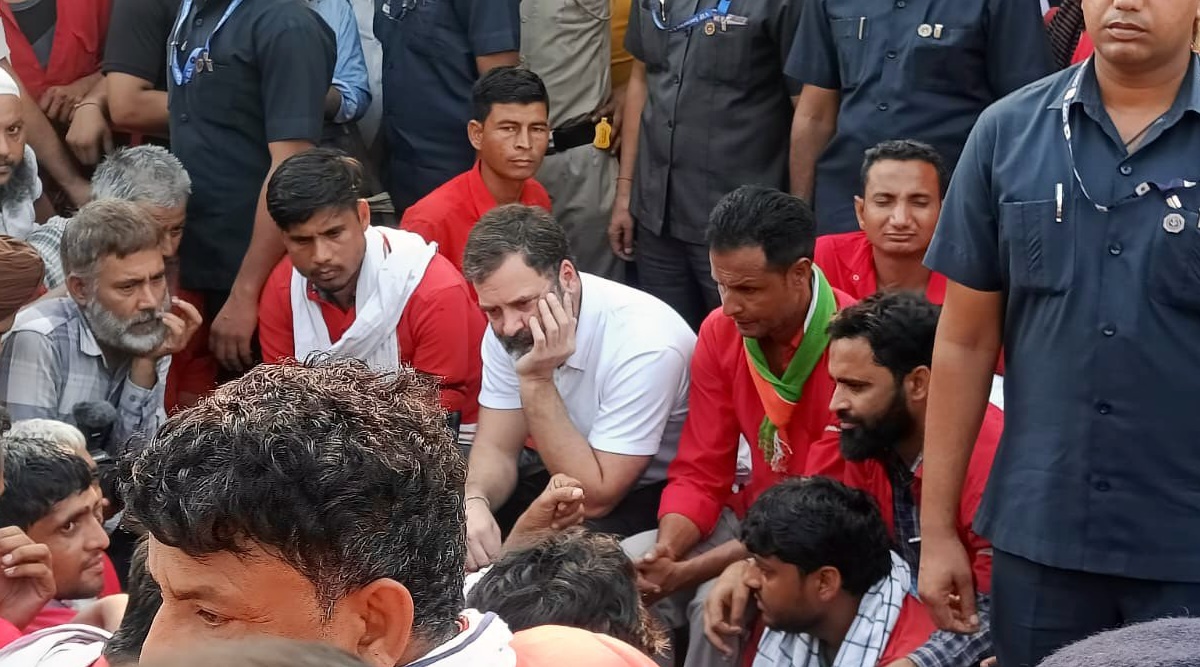Struggling Coolie, Armed with an Engineering Degree, Bemoans Lack of Opportunities

Struggling Coolie, Armed with an Engineering Degree, Bemoans Lack of Opportunities
In a recent interaction at Delhi‘s Anand Vihar railway station, Congress leader Rahul Gandhi engaged in a conversation with a coolie who held an electrical engineering degree but was forced to work as a laborer due to the scarcity of job opportunities. This encounter sheds light on the prevailing issue of unemployment and underemployment in India, as well as the challenges faced by educated individuals in securing suitable employment.
The incident unfolded when Rahul Gandhi, on a visit to the railway station, approached the coolie and inquired about his educational background. To the surprise of many, the coolie revealed that he held a degree in electrical engineering. However, the bitter truth emerged when Rahul probed further, asking why the coolie had not utilized his engineering qualification.
With a touch of resignation, the coolie replied, “How do I do that when there are no jobs?” This simple yet profound response encapsulates the grim reality that numerous educated individuals in India face every day. Despite acquiring degrees in various fields, they find themselves trapped in jobs that are far removed from their qualifications.
The coolie’s statement highlights the pervasive issue of job scarcity, especially in sectors that require technical expertise. The nation’s education system produces a significant number of graduates each year, but the job market struggles to keep pace with this influx of talent. Consequently, highly skilled individuals often find themselves working in menial or low-paying jobs simply to make ends meet.

The coolie’s case also underscores the perceived value of certain degrees in the job market. He referred to his electrical engineering degree as “not useful,” revealing the disillusionment that many graduates experience when they realize that their qualifications do not necessarily guarantee employment opportunities. This raises questions about the alignment of educational curricula with the demands of the job market and the need for greater vocational training and skill development programs.
The unemployment crisis in India is not limited to any specific region or demographic. It affects young and old alike, urban and rural populations, and individuals from diverse educational backgrounds. The COVID-19 pandemic further exacerbated this issue, causing widespread job losses and financial instability.
As a result, many well-educated individuals like the coolie in question are forced to take up jobs that are not commensurate with their qualifications. This underutilization of human potential is a significant impediment to the country’s progress and economic growth. It also leads to a sense of frustration and disillusionment among the youth, who aspire for a brighter future but are held back by systemic challenges.

Addressing the problem of unemployment and underemployment requires a multi-pronged approach. Firstly, there is a need for greater investment in job creation and skill development programs. Government initiatives, private sector collaborations, and vocational training centers can play a pivotal role in equipping individuals with the skills needed to thrive in the job market.
Secondly, there is a pressing need for reforms in the education system to ensure that degrees align more closely with the demands of the job market. This can be achieved through curriculum revisions, industry-academia partnerships, and a stronger emphasis on practical skills and real-world applications.
Additionally, efforts to promote entrepreneurship and create a conducive environment for startups can provide alternative avenues for job seekers. Encouraging a culture of innovation and self-employment can reduce the reliance on traditional job markets.
Moreover, it’s crucial to acknowledge that the issue of unemployment extends beyond the realm of education and skills. Structural issues within the labor market, including limited job security and unequal access to opportunities, also contribute significantly to the problem. Many job seekers face the daunting challenge of securing stable employment with fair wages and benefits, further exacerbating their financial and emotional stress.
Furthermore, the coolie’s story resonates with millions of Indians who have been caught in the cycle of underemployment and inadequate job opportunities. The frustration and disillusionment stemming from unfulfilled aspirations can have far-reaching societal consequences, including increased mental health issues and a sense of hopelessness among the youth.

To address these challenges comprehensively, policymakers, businesses, and civil society organizations must work in tandem to create an ecosystem that fosters job growth, innovation, and inclusivity. This entails not only investing in physical infrastructure but also in social and human capital. Initiatives that focus on healthcare, education, and social safety nets can help mitigate some of the hardships faced by individuals like the coolie, providing a safety net for those who fall through the cracks of the job market.
In conclusion, the encounter between Rahul Gandhi and the coolie underscores the urgency of addressing India’s unemployment and underemployment issues. While education and skill development are critical components of the solution, broader systemic changes are necessary to create a job market that offers dignity, stability, and equitable opportunities to all. The power to transform India’s workforce lies in the hands of those who can effect change through policy reforms, job creation, and social support systems, ultimately paving the way for a brighter and more inclusive future for all.
In conclusion, the encounter between Rahul Gandhi and the coolie with an engineering degree serves as a stark reminder of the challenges faced by educated individuals in India’s job market. The headline, “Struggling Coolie, Armed with an Engineering Degree, Bemoans Lack of Opportunities,” encapsulates the essence of this issue, emphasizing the urgency of addressing unemployment and underemployment through comprehensive reforms, skill development, and entrepreneurship promotion. It is imperative that India harnesses the untapped potential of its educated workforce to drive economic growth and social progress.




